Research end goal: 'improve the quality of human life.'
When it comes to dangerous natural phenomenon, most people think of events like hurricanes, tornadoes and earthquakes.
Hadi Ghasemi – Bill D. Cook Assistant Professor of mechanical engineering at the University of Houston – thinks of ice.
An average of 1,836 deaths and 136,309 injuries per year were attributed to snowy conditions and icy roads between 2005 and 2014 by the Federal Highway Administration. Between 2008 and 2009, there were 19 ice-related road fatalities in Texas and zero tornado-related fatalities.
Air transportation is also impacted by icy conditions. From 1990 to 2000, 12 percent of all weather-related air disasters were due to icing. As the Air Safety Foundation states: “Ice in flight is bad news.”
“I know firsthand the amount of problems icing can cause,” said Ghasemi, who completed his Ph.D. and post-doctoral work in Canada and Boston. During this time, he experienced power outages as well as transportation and infrastructure issues.
“It’s not only about the financial losses, but it also affects the quality of life for the people,” Ghasemi said. “I myself have slipped on ice several times so I know that icing is not a good thing.”
Ghasemi channels his animosity for icing into motivation. “My field of study is surface physics, so I launched a program to study ice formation and find solutions,” he said.
The National Science Foundation has rewarded Ghasemi’s focus with a $290,259 grant for his project titled “Nano-Scale Physics of Icephobicity and Path Toward Durable Icephobic Surfaces.” The multi-disciplinary project involves studies of thermodynamics, heat transfer and mechanics.
A tradition of fighting ice
Ghasemi’s biologically-inspired anti-icing material can withstand critically low temperatures. The new material – which is applied to surfaces as a coating – was one of three winners of the NASA iTech competition in 2017.
The anti-icing coating was inspired by the tiny North American Wood Frog, a creature that can freeze up to 65 percent of its total body water without dying. NASA chose Ghasemi’s project from entries submitted by over 130 organizations across the U.S. for its potential to broadly impact human life on earth and the future of space travel.
Once Ghasemi had plenty proof of concept for his novel material, he partnered with students in his Nano Therm lab to launch the startup SurfEllent and begin marketing the product to consumers.
Other materials created by Ghasemi and his research team include a new magnetic slippery surface (MAGSS), which can be applied to any surface – ceramic, polymers or metals. While pursuing postdoctoral work at the Massachusetts Institute of Technology (MIT), he is credited with creating a low-cost graphite “solar sponge” to convert sunlight into steam for potable water.
A new challenge
Ghasemi, not one to rest on his laurels, is excited about his new NSF-funded challenge.
“This project is basically pure science: to study the underlying principles of ice formation and ice adhesion,” he said. “The most important aspect of this project is that we can get the nanoscale physics of ice formation – which has not been studied before. In nanoscale, we can break the limits of ice formation that we already have and we can suppress ice formation up to temperatures around -40 degrees Fahrenheit. That means most of the time you would avoid any ice formation on any surface.”
Ghasemi’s team is focusing on long-term durability in addition to anti-icing properties. The goal is introduce a new material paradigm offering extreme icephobicity.
“Once we learn this new science, the next step is figuring out how we incorporate this new science in the new type of material,” he said.
There are currently no durable icephobic surfaces or coatings on the market, Ghasemi said – the ones that do exist quickly lose anti-icing properties due to exposure to environmental conditions and must be reapplied frequently.
By comparison, Ghasemi said his anti-icing coatings can last up to seven years after a single application.
He hopes to have the new material developed in about three to five years. “We’re developing the science that will allow us to create a new class of materials with much better performance than what’s available now in the marketplace. It will be revolutionary.”
Once that’s achieved, the possibilities are endless. Ghasemi and his students are already at work on their first paper about this new project. He is also open to future entrepreneurial partnerships, and anticipates research findings paving the way for improved design of technologies used in a variety of industries – from cryobiology and food engineering to energy infrastructure.
“Ice is a problem that will exist as long as we live on the earth. It’s not a problem that’ll disappear in a few years, so we need a solution,” Ghasemi said. “The end goal is to improve the quality of human life.”
